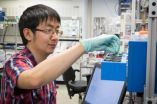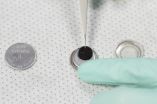(Press-News.org) Menlo Park, Calif. — A comprehensive look at how tiny particles in a lithium ion battery electrode behave shows that rapid-charging the battery and using it to do high-power, rapidly draining work may not be as damaging as researchers had thought – and that the benefits of slow draining and charging may have been overestimated.
The results challenge the prevailing view that "supercharging" batteries is always harder on battery electrodes than charging at slower rates, according to researchers from Stanford University and the Stanford Institute for Materials & Energy Sciences (SIMES) at the Department of Energy's SLAC National Accelerator Laboratory.
They also suggest that scientists may be able to modify electrodes or change the way batteries are charged to promote more uniform charging and discharging and extend battery life.
"The fine detail of what happens in an electrode during charging and discharging is just one of many factors that determine battery life, but it's one that, until this study, was not adequately understood," said William Chueh of SIMES, an assistant professor at Stanford's Department of Materials Science and Engineering and senior author of the study. "We have found a new way to think about battery degradation."
The results, he said, can be directly applied to many oxide and graphite electrodes used in today's commercial lithium ion batteries and in about half of those under development.
His team described the study September 14, 2014, in Natural Materials. The team included collaborators from Massachusetts Institute of Technology, Sandia National Laboratories, Samsung Advanced Institute of Technology America and Lawrence Berkeley National Laboratory.
Watching Ions in Battery Slices
One important source of battery wear and tear is the swelling and shrinking of the negative and positive electrodes as they absorb and release ions from the electrolyte during charging and discharging.
For this study scientists looked at a positive electrode made of billions of nanoparticles of lithium iron phosphate. If most or all of these particles actively participate in charging and discharging, they'll absorb and release ions more gently and uniformly. But if only a small percentage of particles sop up all the ions, they're more likely to crack and get ruined, degrading the battery's performance.
Previous studies produced conflicting views of how the nanoparticles behaved. To probe further, researchers made small coin cell batteries, charged them with different levels of current for various periods of time, quickly took them apart and rinsed the components to stop the charge/discharge process. Then they cut the electrode into extremely thin slices and took them to Berkeley Lab for examination with intense X-rays from the Advanced Light Source synchrotron, a DOE Office of Science User Facility.
New Insights on Faster Discharging
"We were able to look at thousands of electrode nanoparticles at a time and get snapshots of them at different stages during charging and discharging," said Stanford graduate student Yiyang Li, lead author of the report. "This study is the first to do that comprehensively, under many charging and discharging conditions."
Analyzing the data using a sophisticated model developed at MIT, the researchers discovered that only a small percentage of nanoparticles absorbed and released ions during charging, even when it was done very rapidly. But when the batteries discharged, an interesting thing happened: As the discharge rate increased above a certain threshold, more and more particles started to absorb ions simultaneously, switching to a more uniform and less damaging mode. This suggests that scientists may be able to tweak the electrode material or the process to get faster rates of charging and discharging while maintaining long battery life.
The next step, Li said, is to run the battery electrodes through hundreds to thousands of cycles to mimic real-world performance. The scientists also hope to take snapshots of the battery while it's charging and discharging, rather than stopping the process and taking it apart. This should yield a more realistic view, and can be done at synchrotrons such as ALS or SLAC's Stanford Synchrotron Radiation Lightsource, also a DOE Office of Science User Facility. Li said the group has also been working with industry to see how these findings might apply in the transportation and consumer electronics sectors.
INFORMATION:
Research funding came from the Samsung Advanced Institute of Technology Global Research Outreach Program; the School of Engineering and Precourt Institute for Energy at Stanford; the Samsung-MIT Program for Materials Design in Energy Applications; and the U.S. Department of Energy; and the National Science Foundation.
SLAC is a multi-program laboratory exploring frontier questions in photon science, astrophysics, particle physics and accelerator research. Located in Menlo Park, California, SLAC is operated by Stanford University for the U.S. Department of Energy Office of Science.
The Stanford Institute for Materials and Energy Sciences (SIMES) is a joint institute of SLAC National Accelerator Laboratory and Stanford University. SIMES studies the nature, properties and synthesis of complex and novel materials in the effort to create clean, renewable energy technologies. For more information, please visit simes.slac.stanford.edu.
SLAC National Accelerator Laboratory is supported by the Office of Science of the U.S. Department of Energy. The Office of Science is the single largest supporter of basic research in the physical sciences in the United States, and is working to address some of the most pressing challenges of our time. For more information, please visit science.energy.gov.
Citation: W. Chueh et al., Nature Materials, 14 September 2014 (10.1038/NMAT4084)
Study sheds new light on why batteries go bad
Rapid charging and draining doesn't damage lithium ion electrode as much as thought
2014-09-15
ELSE PRESS RELEASES FROM THIS DATE:
Marijuana users who feel low get high
2014-09-15
PISCATAWAY, NJ – Adolescents and young adults who smoke marijuana frequently may attempt to manage negative moods by using the drug, according to a study in September's Journal of Studies on Alcohol and Drugs.
"Young people who use marijuana frequently experience an increase in negative affect in the 24 hours leading up to a use event, which lends strong support to an affect-regulation model in this population," says the study's lead author Lydia A. Shrier, M.D., M.P.H., of the division of adolescent and young adult medicine at Boston Children's Hospital.
She notes ...
Hypersensitivity to non-painful events may be part of pathology in fibromyalgia
2014-09-15
New research shows that patients with fibromyalgia have hypersensitivity to non-painful events based on images of the patients' brains, which show reduced activation in primary sensory regions and increased activation in sensory integration areas. Findings published in Arthritis & Rheumatology, a journal of the American College of Rheumatology (ACR), suggest that brain abnormalities in response to non-painful sensory stimulation may cause the increased unpleasantness that patients experience in response to daily visual, auditory and tactile stimulation.
Fibromyalgia ...
New knowledge of genes driving bladder cancer points to targeted treatments
2014-09-15
The story of cancer care seems so simple: find the mutated gene that causes cancer and turn it off or fix it. But rarely does a single gene cause cancer. More often, many genes are altered together to drive the disease. So the challenge becomes sorting out which altered genes are the most to blame in which cancers. A collaborative study between researchers at the University of Colorado Cancer Center and the National Cancer Institute (NCI) published today in the journal Clinical Cancer Research takes an important step toward answering this question in bladder cancer.
Specifically, ...
Identifying a better message strategy for dissuading smokers: Add the positive
2014-09-15
WASHINGTON — Which is more likely to convince a smoker to quit? The words, "Warning: cigarettes cause cancer" beneath the image of an open mouth with a cancerous lesion and rotten teeth, or the same image with the words, "Warning: Quitting smoking reduces the risk of cancer"?
The answer depends on how confident you are in your ability to quit, according to a study led by researchers at Georgetown Lombardi Comprehensive Cancer Center and published in the journal Nicotine & Tobacco Research.
The research, which involved 740 participants and three D.C. area institutions, ...
To curb violent tendencies, start young
2014-09-15
DURHAM, N.C. -- Aggressive children are less likely to become violent criminals or psychiatrically troubled adults if they receive early intervention, says a new study based on more than two decades of research.
These findings from researchers at Duke, Pennsylvania State and Vanderbilt universities and the University of Washington are based on the Fast Track Project, a multi-faceted program that is one of the largest violence-prevention trials ever funded by the federal government.
Beginning in 1991, the researchers screened nearly 10,000 5-year-old children in Durham, ...
Schizophrenia not a single disease but multiple genetically distinct disorders
2014-09-15
AUDIO:
New research shows that schizophrenia isn't a single disease but a group of eight genetically distinct disorders, each with its own set of symptoms. The finding could be a first...
Click here for more information.
New research shows that schizophrenia isn't a single disease but a group of eight genetically distinct disorders, each with its own set of symptoms. The finding could be a first step toward improved diagnosis and treatment for the debilitating psychiatric illness.
The ...
Vitamin E intake critical during 'the first 1,000 days'
2014-09-15
CORVALLIS, Ore. – Amid conflicting reports about the need for vitamin E and how much is enough, a new analysis published today suggests that adequate levels of this essential micronutrient are especially critical for the very young, the elderly, and women who are or may become pregnant.
A lifelong proper intake of vitamin E is also important, researchers said, but often complicated by the fact that this nutrient is one of the most difficult to obtain through diet alone. It has been estimated that only a tiny fraction of Americans consume enough dietary vitamin E to meet ...
AGA releases new tool to help GIs evaluate and treat Crohn's disease
2014-09-15
Bethesda, MD (Sept. 15, 2014) — The treatment of Crohn's disease is evolving. To help gastroenterologists better identify and manage their Crohn's disease patients, the American Gastroenterological Association (AGA) has created a clinical decision tool to guide GIs in their decision-making process. The "Identification, Assessment, and Initial Medical Treatment in Crohn's Disease Clinical Decision Support Tool," published in Gastroenterology, the official journal of the AGA, synthesizes gastroenterologist's understanding of the disease with data from recent studies to create ...
High-dose opioid prescribing continues to climb
2014-09-12
TORONTO, Sept. 12, 2014 – High-dose opioid prescribing increased by 23 per cent in Canada between 2006 and 2011, despite clinical guidelines recommending that most patients should avoid high-doses of these drugs, according to new research.
Researchers at St. Michael's Hospital and the Institute for Clinical Evaluative Sciences (ICES) found that rates of high-dose opioid dispensing across Canada increased from 781 units per 1,000 people in 2006 to 961 units per 1,000 people in 2011.
"We found that high-dose prescribing was widespread across the country, but the prevalence ...
Study solves the bluetongue disease 'overwintering' mystery
2014-09-12
The bluetongue virus, which causes a serious disease that costs the
cattle and sheep industries in the United States an estimated $125
million annually, manages to survive the winter by reproducing in the
insect that transmits it, report veterinary scientists at the
University of California, Davis.
The findings solve a century-old mystery and are particularly
significant as global climate change brings more moderate winter
temperatures around the world. The new study appears Sept. 12 in the
journal PLOS ONE.
"By conducting this epidemiological study on a commercial ...
LAST 30 PRESS RELEASES:
Making lighter work of calculating fluid and heat flow
Normalizing blood sugar can halve heart attack risk
Lowering blood sugar cuts heart attack risk in people with prediabetes
Study links genetic variants to risk of blinding eye disease in premature infants
Non-opioid ‘pain sponge’ therapy halts cartilage degeneration and relieves chronic pain
AI can pick up cultural values by mimicking how kids learn
China’s ecological redlines offer fast track to 30 x 30 global conservation goal
Invisible indoor threats: emerging household contaminants and their growing risks to human health
Adding antibody treatment to chemo boosts outcomes for children with rare cancer
Germline pathogenic variants among women without a history of breast cancer
Tanning beds triple melanoma risk, potentially causing broad DNA damage
Unique bond identified as key to viral infection speed
Indoor tanning makes youthful skin much older on a genetic level
Mouse model sheds new light on the causes and potential solutions to human GI problems linked to muscular dystrophy
The Journal of Nuclear Medicine ahead-of-print tip sheet: December 12, 2025
Smarter tools for peering into the microscopic world
Applications open for funding to conduct research in the Kinsey Institute archives
Global measure underestimates the severity of food insecurity
Child survivors of critical illness are missing out on timely follow up care
Risk-based vs annual breast cancer screening / the WISDOM randomized clinical trial
University of Toronto launches Electric Vehicle Innovation Ontario to accelerate advanced EV technologies and build Canada’s innovation advantage
Early relapse predicts poor outcomes in aggressive blood cancer
American College of Lifestyle Medicine applauds two CMS models aligned with lifestyle medicine practice and reimbursement
Clinical trial finds cannabis use not a barrier to quitting nicotine vaping
Supplemental nutrition assistance program policies and food insecurity
Switching immune cells to “night mode” could limit damage after a heart attack, study suggests
URI-based Global RIghts Project report spotlights continued troubling trends in worldwide inhumane treatment
Neutrophils are less aggressive at night, explaining why nighttime heart attacks cause less damage than daytime events
Menopausal hormone therapy may not pose breast cancer risk for women with BRCA mutations
Mobile health tool may improve quality of life for adolescent and young adult breast cancer survivors
[Press-News.org] Study sheds new light on why batteries go badRapid charging and draining doesn't damage lithium ion electrode as much as thought






